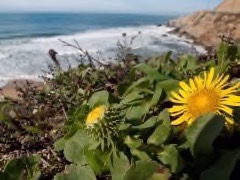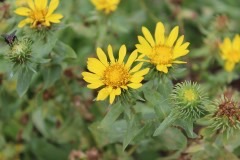 |
|
Franco Folini wikimedia.org |
 |
| BotBln wikimedia.org |
Translate this page:
Summary
An erect perennial herb or subshrub sometimes as much as 250 cm (100 inches or 8 1/3 feet) tall but usually much shorter. Varieties: Grindelia hirsutula var. maritima — San Francisco Gum Plant, San Francisco gumplant, coastal gumweed; endemic to coastal California in the San Francisco Bay Area.
Physical Characteristics

 Grindelia hirsutula is an evergreen Perennial growing to 1 m (3ft 3in) by 0.3 m (1ft) at a fast rate.
Grindelia hirsutula is an evergreen Perennial growing to 1 m (3ft 3in) by 0.3 m (1ft) at a fast rate.
See above for USDA hardiness. It is hardy to UK zone 8. The flowers are pollinated by Insects.
Suitable for: light (sandy) and medium (loamy) soils, prefers well-drained soil and can grow in nutritionally poor soil. Suitable pH: mildly acid, neutral and basic (mildly alkaline) soils and can grow in very acid and very alkaline soils.
It cannot grow in the shade. It prefers dry or moist soil and can tolerate drought.
UK Hardiness Map
US Hardiness Map
Synonyms
Many but with a low confidence level.
Plant Habitats
Edible Uses
References More on Edible Uses
Medicinal Uses
Plants For A Future can not take any responsibility for any adverse effects from the use of plants. Always seek advice from a professional before using a plant medicinally.
Eczema
Gumplant was used by the native North American Indians to treat bronchial problems and also skin afflictions such as reactions to poison ivy[254 ]. It is still used in modern herbalism where it is valued especially as a treatment for bronchial asthma and for states where phlegm in the airways impedes respiration[254 ]. In addition, it is believed to desensitize the nerve endings in the bronchial tree and slow the heart rate, thus leading to easier breathing[254 ]. The herb is contraindicated for patients with kidney or heart complaints[254 ]. The dried leaves and flowering tops are antiasthmatic, anti-inflammatory, antispasmodic, expectorant and sedative[4 , 61 , 165 , 238 ]. The principal use of this herb is in the treatment of bronchial catarrh, especially when there is an asthmatic tendency, it is also used to treat whooping cough and cystitis[4 , 61 , 238 ]. The active principle is excreted from the kidneys, and this sometimes produces signs of renal irritation[4 , 238 ]. Externally, the plant is used to treat burns, poison ivy rash, dermatitis, eczema and skin eruptions[61 , 238 ]. The plant is harvested when in full bloom and can be used fresh as a poultice or dried for infusions etc[238 ]. A homeopathic remedy is prepared from the leaves and flowering stems[4 ].
References More on Medicinal Uses
The Bookshop: Edible Plant Books
Our Latest books on Perennial Plants For Food Forests and Permaculture Gardens in paperback or digital formats.

Edible Tropical Plants
Food Forest Plants for Hotter Conditions: 250+ Plants For Tropical Food Forests & Permaculture Gardens.
More

Edible Temperate Plants
Plants for Your Food Forest: 500 Plants for Temperate Food Forests & Permaculture Gardens.
More

More Books
PFAF have eight books available in paperback and digital formats. Browse the shop for more information.
Shop Now
Other Uses
Yellow and green dyes are obtained from the flowering heads and pods[168 ]. Aromatic. A possible substitute for wood rosin, used in the manufacture of adhesives etc[160 ]. This report probably refers to the resin that covers the flower buds. Carbon Farming - Industrial Crop: hydrocarbon.
Special Uses
Carbon Farming
References More on Other Uses
Cultivation details
Experimental Crop Industrial Crop: Hydrocarbon Management: Hay
Climate: cold to warm temperate. Humidity: arid to semi-arid. Succeeds in any well-drained soil in full sun[200 ]. Does well on dry sandy banks and in poor soils[200 ]. This species is not hardy in the colder areas of the country, it tolerates temperatures down to between -5 and -10°c[200 ]. A very variable species, it is comprised of a number of forms that were previously recognised as distinct species but, in the Flora of North America[270 ], have all been treated as synonyms of this species. A number of these species are included in this database and, for the present are all being retained here. Species affected are Grindelia camporum, Grindelia humilis and Grindelia robusta[K ]. All parts of the plant have a balsamic odour[238 ]. Carbon Farming - Cultivation: experimental. Management: hay.
Carbon Farming
-
Experimental Crop
Plant breeders are testing these plants to see if they could be domesticated for cultivation, but they are still in an experimental phase. Examples include milkweed and leafy spurge.
-
Industrial Crop: Hydrocarbon
Materials, chemicals and energy include bioplastics, rubber, biomass products gasoline, jet fuel, diesel, butane, propane, biogas. Plants are usually resprouting plants and saps.
-
Management: Hay
Cut to the ground and harvested annually. Non-destructive management systems maintaining the soil organic carbon.
References Carbon Farming Information and Carbon Sequestration Information
Temperature Converter
Type a value in the Celsius field to convert the value to Fahrenheit:
Fahrenheit:
The PFAF Bookshop
Plants For A Future have a number of books available in paperback and digital form. Book titles include Edible Plants, Edible Perennials, Edible Trees,Edible Shrubs, Woodland Gardening, and Temperate Food Forest Plants. Our new book is Food Forest Plants For Hotter Conditions (Tropical and Sub-Tropical).
Shop Now
Plant Propagation
Seed
Other Names
If available other names are mentioned here
Hairy gumplant and hairy gumweed.
Native Range
NORTHERN AMERICA: United States (Oregon, California)
Weed Potential
Right plant wrong place. We are currently updating this section.
Please note that a plant may be invasive in one area but may not in your area so it's worth checking.
None Known
Conservation Status
IUCN Red List of Threatened Plants Status : This taxon has not yet been assessed

Growth: S = slow M = medium F = fast. Soil: L = light (sandy) M = medium H = heavy (clay). pH: A = acid N = neutral B = basic (alkaline). Shade: F = full shade S = semi-shade N = no shade. Moisture: D = dry M = Moist We = wet Wa = water.
Now available:
Food Forest Plants for Mediterranean Conditions
350+ Perennial Plants For Mediterranean and Drier Food Forests and Permaculture Gardens.
[Paperback and eBook]
This is the third in Plants For A Future's series of plant guides for food forests tailored to
specific climate zones. Following volumes on temperate and tropical ecosystems, this book focuses
on species suited to Mediterranean conditions—regions with hot, dry summers and cool, wet winters,
often facing the added challenge of climate change.
Read More
Expert comment
Author
Hook. & Arn.
Botanical References
Links / References
For a list of references used on this page please go here
A special thanks to Ken Fern for some of the information used on this page.
Readers comment
| Add a comment |
|
If you have important information about this plant that may help other users please add a comment or link below. Only comments or links that are felt to be directly relevant to a plant will be included. If you think a comment/link or information contained on this page is inaccurate or misleading we would welcome your feedback at [email protected]. If you have questions about a plant please use the Forum on this website as we do not have the resources to answer questions ourselves.
* Please note: the comments by website users are not necessarily those held by PFAF and may give misleading or inaccurate information.
To leave a comment please Register or login here All comments need to be approved so will not appear immediately.
|
Subject : Grindelia hirsutula
|
|
|
|